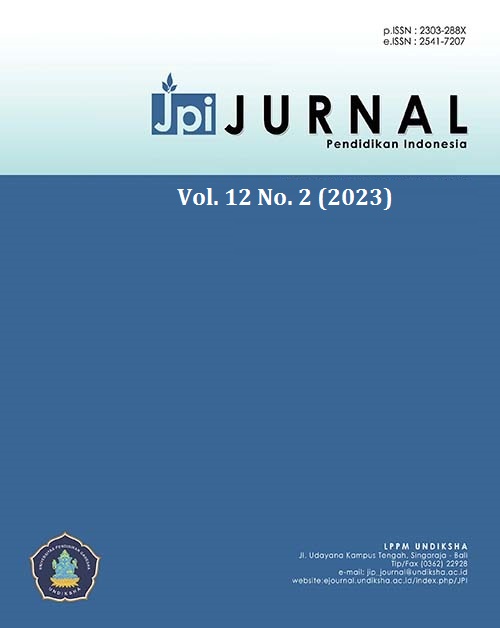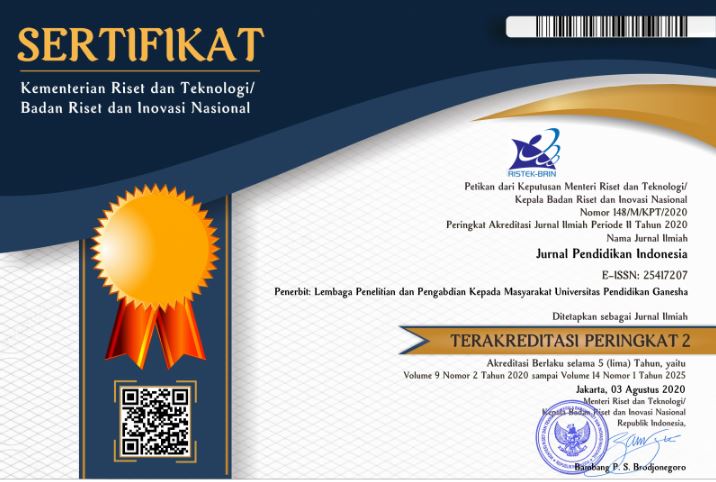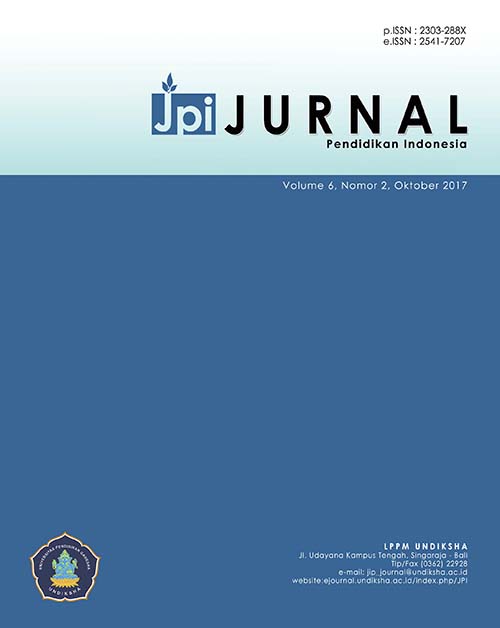The Effect of the Empirical Base Nature of Science Learning Model on the Understanding of Nature of Science in Empirical Aspect
DOI:
https://doi.org/10.23887/jpiundiksha.v12i2.56522Keywords:
Nature of Science, Empirical Base, EBNOS Learning Model, Elementary School StudentsAbstract
Understanding of the nature of science, especially the empirical aspect, is now receiving less attention and seriousness from the educational community. The aim of this study was determine the effect of the Empirical Base Nature of Science (EBNOS) learning model on understanding NOS, especially on the empirical aspects of elementary school students. This study used a pre-experimental method through a one group pretest posttest design. The research subjects selected by convenience sampling were 51 students of class V of a private elementary school in the city of Bandung. The instrument used to collect data related to students' understanding of NOS at the pretest and posttest uses a Likert scale. Additional aspects explored from research subjects to support research results are aspects of gender and interest in science. Quantitative descriptive method with the help of SPSS and Microsoft Excel was used to analyze the data collected from the questionnaire. The results showed that the application of the Empirical Base Nature of Science (EBNOS) learning model design had a significant effect on increasing students' understanding of NoS, especially on the empirical aspect. However, understanding of the empirical aspect of NOS was not influenced by the gender of the students or their interest in science itself. This research is expected to contribute to the improvement of the learning process which aims to achieve science learning goals on the NOS dimension, especially on the empirical aspect. Suggestions for further research are developing specific learning models that can improve understanding of NOS in other aspects.
References
Abd-El-khalick, F., & Lederman, N. G. (2000). Improving science teachers’ conceptions of nature of science: A critical review of the literature. In International Journal of Science Education. https://doi.org/10.1080/09500690050044044.
Adi, Y, K., & Widodo, A. (2018). Pemahaman Hakikat Sains Pada Guru Dan Siswa Sekolah Dasar. Edukasi Journal, 10(1), 55–72. https://doi.org/10.31603/edukasi.v10i1.1831.
Aflalo, E. (2018). Changes in the perceptions of the nature of science and religious belief. Issues in Educational Research, 28(2), 237–253. https://search.informit.org/doi/abs/10.3316/ielapa.673015679881646.
Allchin, D. (2011). Evaluating knowledge of the nature of (whole) science. Science Education, 95(3), 518–542. https://doi.org/10.1002/sce.20432.
Borg, W R & Gall, M. D. (2003). Educational Research: an Introduction (7th. ed). New York: Logman Inc.
Creswell, W. J. (2013). Research Design Pendekatan Kualitatif, Kuantitatif, dan Mixed. Yogyakarta : Pustaka Pelajar.
Dogan, N., & Abd-El-Khalick, F. (2008). Turkish grade 10 students’ and science teachers’ conceptions of nature of science: A national study. Journal of Research in Science Teaching, 45(10), 1083–1112. https://doi.org/10.1002/tea.20243.
Gall, M. D., Gall, J. P., & Borg, W. R. (2010). Applying Educational Research. Pearson Education.
Gunawan, G., Mashami, R. A., & Herayanti, L. (2020). Gender description on problem-solving skills in chemistry learning using interactive multimedia. Journal for the Education of Gifted Young Scientists, 8(1), 571–589. https://doi.org/10.17478/jegys.627095.
Hardianty, N. (2015). Nature of Science : Bagian Penting Dari Literasi Sains. Prosiding Simposium Nasional Inovasi Dan Pembelajaran Sains 2015 (SNIPS 2015), 441–444. https://ifory.id/proceedings/2015/z4pZjcJkq/snips_2015_noer_hardianty_ea97da1831f769d29607806cda9e4f5e.pdf.
Imran, M. E., & Wibowo, A. (2018). Profil Pemahaman Nature Of Science (NNOS) Di Sekolah Dasar. JKPD (Jurnal Kajian Pendidikan Dasar), 3(2), 540–557. https://doi.org/10.26618/jkpd.v3i2.1420.
Jumanto, J., & Widodo, A. (2018). PEMAHAMAN HAKIKAT SAINS OLEH SISWA DAN GURU SD DI KOTA SURAKARTA. Jurnal Komunikasi Pendidikan, 2(1), 20–31. https://doi.org/10.32585/jkp.v2i1.61
Kampourakis, K. (2016). The “general aspects” conceptualization as a pragmatic and effective means to introducing students to nature of science. Journal of Research in Science Teaching, 53(5), 667–682. https://doi.org/10.1002/tea.21305.
Kelly, R., & Erduran, S. (2019). Understanding aims and values of science: developments in the junior cycle specifications on nature of science and pre-service science teachers’ views in Ireland. Irish Educational Studies, 38(1), 43–70. https://doi.org/10.1080/03323315.2018.1512886.
Khishfe, R., Alshaya, F. S., BouJaoude, S., Mansour, N., & Alrudiyan, K. I. (2017). Students’ understandings of nature of science and their arguments in the context of four socio-scientific issues. International Journal of Science Education, 39(3), 299–334. https://doi.org/10.1080/09500693.2017.1280741.
Köksal, M. S. (2009). An instructional design model to teach nature of science. Asia-Pacific Forum on Science Learning and Teaching, 10(2). https://www.academia.edu/download/57737269/Article_Erik_Pebri_Karlepi_.pdf.
Lederman, Norm G., Abd-El-Khalick, F., Bell, R. L., & Schwartz, R. S. (2002). Views of Nature of Science Questionnaire: Toward Valid and Meaningful Assessment of Learners’ Conceptions of Nature of Science. Journal of Research in Science Teaching, 39(6), 497–521. https://doi.org/10.1002/tea.10034.
Lederman, Norman G., Schwartz, R., & Abd-El-Khalick, F. (2014). Nature of Science, Assessing of. In Encyclopedia of Science Education. https://doi.org/10.1007/978-94-007-6165-0_12-2.
Lederman, Norman G, Lederman, J. S., & Antink, A. (2013). Nature of Science and Scientific Inquiry as Contexts for the Learning of Science and Achievement of Scientific Literacy. International Journal of Education in Mathematics Science and Technology (IJEMST) International Journal of Education in Mathematics Science and Technology International Journal of Education in Mathematics Science and Technology, 1(3), 138–147. https://eric.ed.gov/?id=ED543992.
Lestari, H. (2020). Peningkatan Pemahaman Nature Of Science (Nos) Siswa Melalui Model Pembelajaran Inkuiri Terbimbing Ditinjau Dari Tingkat Efikasi Diri. Reslaj : Religion Education Social Laa Roiba Journal, 2(2), 219–242. https://doi.org/10.47467/reslaj.v2i2.146.
Lestari, H., & Widodo, A. (2021). Peranan Model Pembelajaran Nature of Sains Terhadap Peningkatan Pemahaman Sains Siswa Di Sekolah Dasar. Jurnal Cakrawala Pendas, 7(1). https://doi.org/10.31949/jcp.v7i1.2425.
Listiani, & Kusuma, A. E. (2017). View Of Nature Of Science (Vnos) Form B: Sebuah Instrumen Untuk Mengetahui Pemahaman Konsep Hakikat Sains Calon Guru Di Universitas Borneo Tarakan. Jurnal Pendidikan Biologi Indonesia, 3, 45–54. http://download.garuda.kemdikbud.go.id/article.php?article=640224&val=7984&title=View of nature of science VNOS form B An instrument for assessing pre-service teachers view of nature of science at Borneo University Tarakan.
Marchetti, L., & Cullen, P. (2015). A Multimodal Approach in the Classroom for Creative Learning and Teaching. Psychological and Creative Approaches to Language Teaching, 39–51. https://doi.org/10.1016/j.bbalip.2011.04.004.
McComas, W. (2017). Understanding how science works: The nature of science as the foundation for science teaching and learning. School Science Review, 98(365), 71–76. https://www.researchgate.net/profile/William-Mccomas/publication/318912990_Understanding_how_science_work_The_nature_of_science_as_they_foundation_for_science_teaching_and_learning/links/5984d78d458515605844ef47/Understanding-how-science-work-The-nature-of-science-as-they-foundation-for-science-teaching-and-learning.pdf.
McComas, W. F. (2015). The Nature of Science and the Next Generation of Biology Education. American Biology Teacher, 77(7), 485-491Metin. https://doi.org/10.1525/abt.2015.77.7.2.
Metin, M., Acisli, S., & Kolomuc, A. (2012). Attitude of Elementary Prospective Teachers Towards Science Teaching. Procedia - Social and Behavioral Sciences, 106(2), 157–168. https://doi.org/10.1016/j.sbspro.2012.05.418.
Michel, H., & Neumann, I. (2014). Nature of science and science content learning: can NOS instruction help students develop a better understanding of the energy concept? National Association of Research in Science Teaching (NARST) Pittsburgh, Pennsylvania, 1–10. https://www.ipn.uni-kiel.de/de/das-ipn/abteilungen/didaktik-der-physik/narst14/michelNARST14paper.pdf.
Mudavanhu, Y., & Zezekwa, N. (2017). The Views of Nature of Science Expressed by In-Service Teachers Who were Learning History and Philosophy of Science. Journal of Educational and Social Research, 7(3), 39. https://doi.org/10.1515/jesr-2017-0003.
Nurmaulida, L. (2016). Tingkat Pemahaman Nature of Science (NoS) Siswa SMA Se-Kota Tegal. In SNSE III 2016., 234–239. https://prosiding.upgris.ac.id/index.php/snse/snse/paper/view/994/0.
Pellegrino, J. W. (2002). Knowing what students know: the science and design of educational assessment. Issues in Science and Technology, 19(2), 48–52. https://www.jstor.org/stable/43312299.
Rahayu, A. H., & Widodo, A. (2019). Understanding of Nature of Science Pre-Service Students and Elementary School Teachers in the Digital Age. Formatif: Jurnal Ilmiah Pendidikan MIPA, 9(2), 161–172. https://doi.org/10.30998/formatif.v9i2.3251.
Rato, J. R., Amorim, J., & Castro-Caldas, A. (2022). Looking for the Brain Inside the Initial Teacher Training and Outreach Books in Portugal. Frontiers in Psychology, 13. https://doi.org/10.3389/fpsyg.2022.737136.
Rudolph, J. L. (2003). Portraying Epistemology: School Science in Historical Context. Science Education, 45(3). https://doi.org/10.1002/sce.1055.
Sadia, I. W. (2008). Model Pembelajaran yang Efektif untuk Meningkatkan Keterampilan Berfikir Kritis(Suatu Persepsi Guru). Jurnal Pendidikan Dan Pengajaran UNDIKSHA, 2(1), 09–18. https://doi.org/ISSN 02158250.
Solomon, J., Duveen, J., Scot, L., & McCarthy, S. (1992). Teaching about the nature of science through history: Action research in the classroom. Journal of Research in Science Teaching, 29(4), 409–421. https://doi.org/10.1002/tea.3660290408.
Subagia, I. W., & Wiratma, I. G. L. (2009). Potret" Pelaksanaan Pembelajaran Sains pada Berbagai Jenjang Sekolah di Bali. Jurnal Pendidikan Dan Pembelajaran (JPP), 14(1). http://journal.um.ac.id/index.php/pendidikan-dan-pembelajaran/article/view/799.
Sudirgayasa, I. G., Suastra, I. W., & Ristiati, N. P. (2014). Pengaruh Model Pembelajaran Berbasis Nature Of Science ( NOS ) Terhadap Kemampuan Aplikasi Konsep Biologi Dan Pemahaman NOS Siswa Dalam Pembelajaran Biologi di SMA Negeri 1 Marga. Program Pascasarjana Universitas Pendidikan Ganesha, 4(1), 1–12. https://ejournal-pasca.undiksha.ac.id/index.php/jurnal_ipa/article/view/1294/0.
Sutinah, C., & Widodo, A. (2020). The Effect of Nature of Science (NoS) Explicit Learning Design on Students’ NoS Comprehension at Elementary School. Al Ibtida: Jurnal Pendidikan Guru MI, 7(2), 197–209. https://doi.org/10.24235/al.ibtida.snj.v7i2.7167.
Tala, S., & Vesterinen, V. M. (2015). Nature of Science Contextualized: Studying Nature of Science with Scientists. Science and Education, 24(4). https://doi.org/10.1007/s11191-014-9738-2.
Downloads
Published
Issue
Section
License
Copyright (c) 2023 Duhita Savira Wardani, Ari Widodo, Ryan Dwi Puspita

This work is licensed under a Creative Commons Attribution-ShareAlike 4.0 International License.
Authors who publish with the Jurnal Pendidikan Indnesia agree to the following terms:
- Authors retain copyright and grant the journal the right of first publication with the work simultaneously licensed under a Creative Commons Attribution License (CC BY-SA 4.0) that allows others to share the work with an acknowledgment of the work's authorship and initial publication in this journal.
- Authors are able to enter into separate, additional contractual arrangements for the non-exclusive distribution of the journal's published version of the work (e.g., post it to an institutional repository or publish it in a book), with an acknowledgment of its initial publication in this journal.
- Authors are permitted and encouraged to post their work online (e.g., in institutional repositories or on their website) prior to and during the submission process, as it can lead to productive exchanges, as well as earlier and greater citation of published work. (See The Effect of Open Access)








